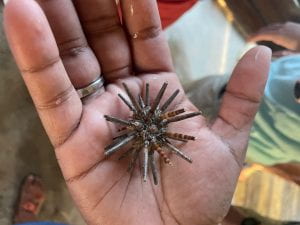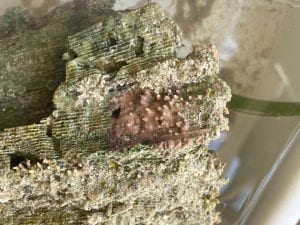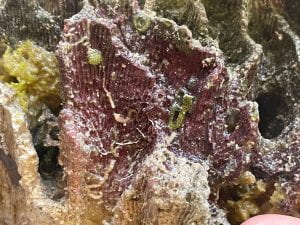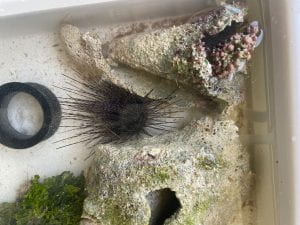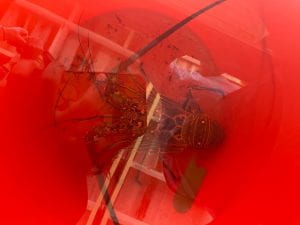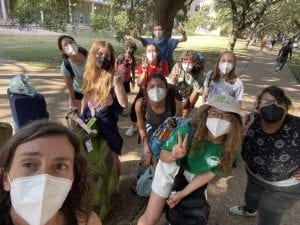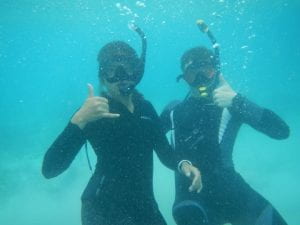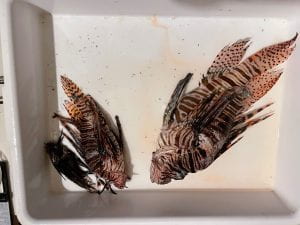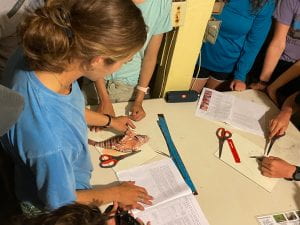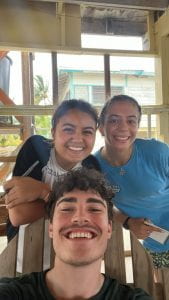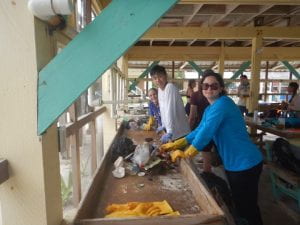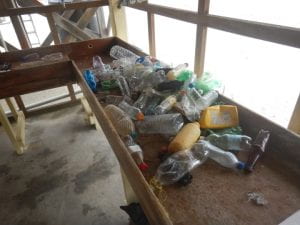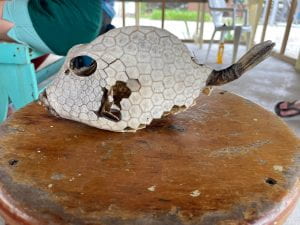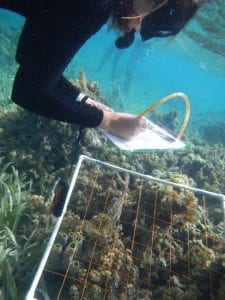All posts by Sophia Figueroa
Day 12: Speedy TFBs
Today we started off our last day in Las Cuevas by collecting our arthropod pitfall traps and sorting through the data in the morning. We found that there were more insects on the forest floor than in the canopy but the we were wrong about the canopy arthropods would be more attracted to the nitrogen rich trap. Afterwards, some people started our poster while me, Dr. Correa, and a few others sped hiked through the motion camera trap trails to collect them and get the data. It was super fun to speed hike through and see the same plants and areas of trail in a completely different way. Now that we didn’t have to worry about biasing data placement, etc., I was able to hike and just enjoy it as a hike itself. What’s even better is that it started to rain pretty hard once we finished the steep uphill of Bird Tower Trail so we were nice and refreshed by the time we returned to the station. The rain was also beautiful to watch and listen to, the ponds slowly filling up and preparing themselves for the many frogs that will soon inhibit them.
After we finished up packing and were waiting for the vans, one of the station managers Darrio pointed out that you could hear what sounded like hundreds of Mexican Burrowing Toads croaking from the wallows/frog pond area. A few of us decided to check it out and it was so cool. Once you step into the pond area, it was a 360º surrounding of the frogs croaking. Sadly we didn’t see any as they are burrowed in the ground but it was still really cool to hear them as the wet season kicks in.
Once we left Las Cuevas and made our way to the hotel, I was able to still spot lots of epiphytes. Since settling in our new rooms, I have identified lots of Tillandsia spp. and Philodendron hederaceum. It’s pretty cool to see that they still thrive outside of the forest – and who knows, maybe I’ll be able to spot some back in Houston (in the wild or as house plants) 😉
– Sophia

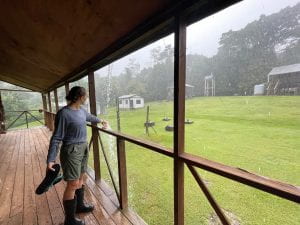
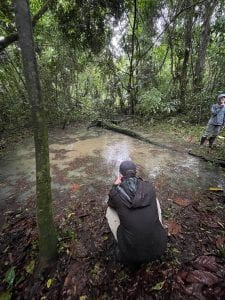
Day 11: Lucky Charm TFBs (Sorry for Jinxing It)
Two true TFB experiences today: I woke up at 5am to join some of the group for some bird watching and peed in a test tube. Waking up was a little rough at first but it was worth it. It was super cool to see the morning mist around the fog and drink coffee while watching the Black Vultures hang out on their canopy spot. The dawn chorus was also super pretty (where all of the birds sing in the morning) and looking out into the trees while waking up was pretty peaceful. I also got some people to start throwing around a frisbee !! But I promise ultimate ishn’t my main personality trait… After breakfast, we started our next experiment – seeing the differences of arthropod abundance in the canopy versus the forest floor. One way to test this is by placing a pitfall trap with nitrogen in it and a water in the other one. How do you get the nitrogen source into the pitfall? Our pee.
For the rest of the morning before lunch we set up our 64 pitfall traps on the tree and in the forest floor. I spotted some Mistletoe Cactus (an epiphyte) too! And of course lots of Tillandsia spp., Monstera spp., and Philodendron radiatum and hederacum. As soon as we got on the trail to set up, we came across a Jumping Pit Viper and an Eyelash Viper. Apparently the manager of the station hasn’t seen on in the wild in the past 12 years and it’s insane that we were able to find one. Then after lunch, we got to excavate some Leaf Cutter Ant nests to try to find their fungal garden looking at young ones first and then old ones. While searching for the nests and prepping for the excavation we saw a Tarantula Hawk, scorpions, a Orb-Weaver Spider, and Ant Lion holes. When we looked through the young one, we were able to find the queen which was absolutely giant – she can live up to 25 years and has a bunch of eggs that she lays over time after only mating once. Two kinds of worker ants that work as a defense layer are called Majors and Soldiers. These have huge heads that have really sharp mandibles and do not hesitate to bite you and draw blood. While looking at the first of the two bigger nests, we found a rare (to find) Mexican Burrowing Toad which was SO cute and funny looking. A big highlight of the day was seeing a super happy and excited Rusty. Looking at the second of the larger nests, there was many more major and soldier ants, and a much larger fungal garden and we got to see the architecture of the nest more.
After dinner, as we got to go on an optional night hike which was definitely 100% 12/10 worth doing, I almost stopped on a Red-Rump Tarantula. I really think my clumsiness has amplified 10 fold over the past week and a half. As we walked through the trail, it really felt like we were on the set of a movie with the way our headlamp moved across the towering palms. We encountered two (!!) Morelet’s Tree Frogs which is a critically endangered species which is tragic as these guys are super cute. They even jumped on some people and we had a fun tree frog photoshoot. As we made it to the same wallow as yesterday, we saw that the same Red-Eyed Tree Frog (possibly Morelet’s as well) eggs where being preyed upon by a Northern Cat Eye snake. We actually got to watch the snake’s process of stalking the eggs slowly and taking multiple trips to get as many eggs as possible. It was super cool to be able to observe behaviors of the more nocturnal organisms and basically unlock another world.
-Sophia
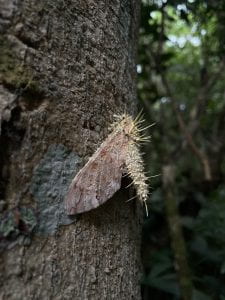
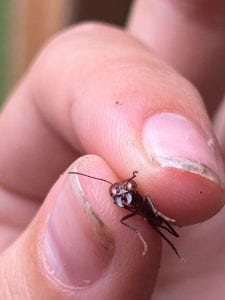

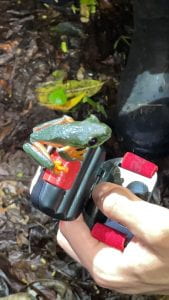
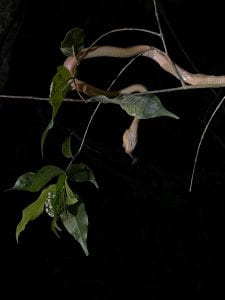
Day 10: New Heights
This morning after breakfast, we created our camera trap experiment in which we are going to use fifteen motion cameras that will take photos over the next few days. We are going to try to identify the different predators and prey and see where they might be most abundant in the different areas of the foot trails, untouched forest, and the “paved” roads. We set out for a couple of hours before lunch to begin our camera set up, mainly putting up our five cameras for the road areas. After lunch, we then set out for the true hiking experience to put up the other 10 or so cameras. I was impressed with the amount of elevation that we gained throughout the hike, rubber boots adding to some of the difficulty when we had to go down hill (they are super important for protection against snakes and also great for the rain and puddles) but I think this is because mine could do with some extra traction but I still very much enjoyed the hike. The vegetation within the forest was unbelievable. I just feel like everything is magnified by 10x, it’s gorgeous. I saw huge Give and Take Palms, plenty of fish tail palms, huge Tillandsia utriculata (the same genus as the small airplants but this one can grow up to 60cm) in many of the tree canopies, and a lot of house plants that were obviously thriving more out here in the jungle than someone’s plant room: Philodendron radiatum, Philodendron hederaceum and a lot of Monstera spp. I also saw a lot of air-plants that were both on the tree at around eye level but also a few that had fallen to the ground because the branch that they were connected to had broken off. These were Tillandsia spp. but they all are so similar that I’m learning that deciphering the exact species is going to be more difficult than I expected. Along the way, we saw so many different butterflies, a huge cockroach, lots of cicada shells, leaf cutter ants, and even got to eat some termites. Since they were so small, it wasn’t scary to eat them – they mostly had a woody aftertaste to them but I don’t know if I’d go out of my way to find and eat them.

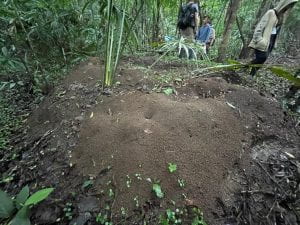
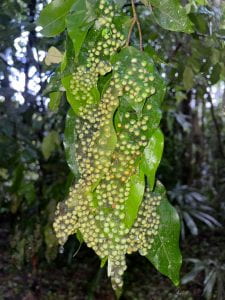
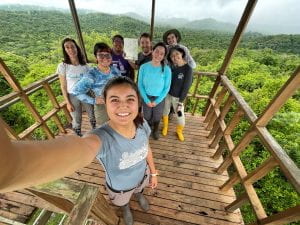
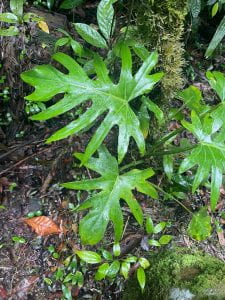
After we finished the elevation climb, we made it to the Bird Tower where we went up this questionably stable structure that had the most amazing outlook I have ever seen. You could see so much of the forest yet only understand that it is only a part of the whole thing, it was gorgeous. On the hike down from the top, we stopped at the smaller Mayan cave were we found some Mayan clay pottery shards and got to explore the room that had been built by building a wall into the natural constrictions of the cave. The stalactites were so impressive and I could have stared at them all day, but I’m excited for the cave we get to explore in a few days. As we were trying to pass the time, I have also learned so many riddles and I can’t wait to stump everyone one at home. On the way back down Dr. Solomon also pointed out some orchids but I couldn’t identify them because there were no flowers. However, pseudobulbs led us to believe that they were orchids. Our final stop was a ginormous leaf cutter ant mound that was about 6ft wide (at least). It is so cool to watch the Leaf Cutter ants all line up and create their foraging trails as they cut down the vegetation to bring into their home to cultivate the fungus that they eat the byproduct of. I’m starting to understand why Dr. Solomon loves ants so much. We also stopped by a wallows (in the dry season)/frog pond (in the wet season) and found a bunch of Red-eyed Tree Frog eggs on a hanging tree branch – super cool!
-Sophia
Day 9: Epiphytes Galore
Even though today was another travel day, we managed to spend a large part of it at the Mayan Ruins of Caracol!! It was super cool because we actually got to climb on top of them and go through the rooms and tombs. We first started out learning a bit of Mayan history from Leo, our tour guide. He explained how there was a two class system: the elites and the middle class that worked for the elites. The builds of their houses were different (completely stone vs. thatched) as well as their burial methods like how intricate the tombs were and what was put inside. My favorite stop that we made was at the large pyramidal temple that a Mayan king had actually built his palace on top of, securing his status as a god or at least that it was he was divinely chosen. We got to climb onto the temple to the very top where the stairs were surprisingly tall and steep – the Mayans must have had some serious quads not gonna lie. Within Caracol, there were about 200,000 people living in 35,000 homes at one point, but Leo told us of possible reasons why the Mayan civilization fell: 1) War – self explanatory, 2) Degradation of the environment – using too many of the resources around them and a butterfly effect of affecting the organisms and habitats around them, 3) Revolt – archaeologists have found evidence from purposefully destroyed statues to finding skeletons found in mass graves/unusual spots by the palace (around which they were trying to construct a wall for protection against their own people). It was mind blowing to see these ruins in such an up-close perspective and understand how they went about daily lives. The view from on top was beautiful as you could see so much of the Chiquibul forest and its inhabitants and listen to the beautiful cacophony that is created within.
The cicadas here sounds so different than the one’s at home (they kind of sound like a constant drone flying overhead) and the Melodious Blackbirds have a super distinct call that I am sure we will hear plenty of over the next week. During lunch, we even hear the loud croak/groans of the Howler Monkeys! In terms of some of my taxa sightings (epiphytes!!), I saw plenty. I saw lots of Arrowhead Plants, Tillandsia utriculata, Philodendron hederaceum, and Monstera spp. Lots of these were growing on these super cool 200+ year old Ceiba trees that had plenty of epiphytes growing on them and here at least 100ft tall – so amazing. We also saw a Gumbo limbo tree which is funnily also known as the Tourist Tree as it has a red colored bark that peels off, just like the American tourists that come and visit.
Afterwards we headed to Las Cuevas Research Station where in the car we saw a toucan, scarlet macaw, and lots of turtles that were crossing the road. The station is super nice and we were able to get in yesterday’s taxon briefings in as well as those scheduled for today so I presented about epiphytes! I’m actually really excited to get into trying to ID them and also teaching the group about them as they are definitely very present in the forest.
-Sophia
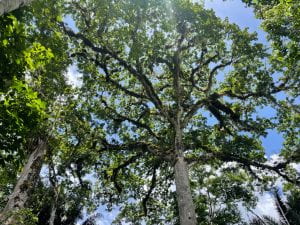
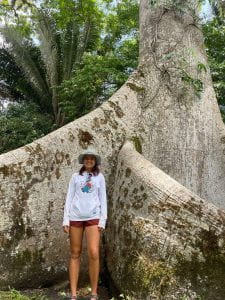
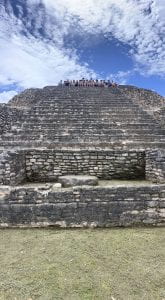
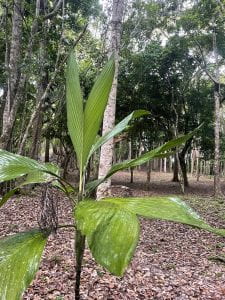
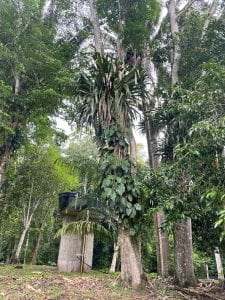
Day 8: Night at the Zoo (get it..?)
A great start to another exciting adventure on our trip. Today we left Glover’s and took the 4 hour boat ride back, which I slept all the way through thanks to the anti-nausea medicine everyone took. We stopped for a pretty long lunch as there was only one cook at the restaurant, but I took the opportunity to have my last super fresh snapper along with a refreshing virgin piña colada. We then headed out in our vans to make a quick stop at the market before heading to where we’re staying for the night, the Tropical Education Center.
The Tropical Education center is a part of the Belize Zoo and has really nice facilities with cabanas that everyone is staying in for the night. Once we settled in and put our stuff down, we had a great presentation by Borris Avelaro about his research about the Scarlet Macaw, conservation, and why it is important to ignore the toxicity of publishing within academia and sharing your data as soon as possible with others so the species you are studying has a chance at surviving. As soon as we left the classroom, Ava pointed out the first epiphyte of the trip! A Vase Bromeliad. There are actually a lot of these popping up around the site we’re staying at and I’m excited to see what I’ll find at Las Cuevas.
After dinner, we headed out to our late night zoo excursion. Here, we were given a guided tour around the Belize Zoo that only hosts Belize’s native species. Another cool thing about the zoo is that all of the animals are rescued from being pets, confiscations, and other injuries. The zoo is also trying to show Belizeans the animals that they live beside and disprove the myths and superstitions that may surround the animals. We saw jaguars, pumas (both incredibly smart cats), and Quashes (who are related to raccoons) and got to hear the funny noises of the ocelot eating – as everyone pointed out, it sounded very happy yet very angry about eating its food. My favorite animal we got to see was Archie the anteater. He was super active in the trees – I didn’t realize that some anteaters could climb around trees like he did but it was so freaking cute. He also had a huge termites nest that he created his own nest in so he basically has a food source at all times when he’s awake and asleep. Genius. Lastly, we got to feed Indy the tapir who was also very cute. She loved carrots and we even got to pet her when she was distracted by her snacks. She’s also related to horses and rhinos and you can tell this because… Every time we left an animal, the keeper would say “Thank you, [insert animal’s name]” and it was the most precious thing I’ve heard because you can see their connection with the animals that they take care of.
– Sophia

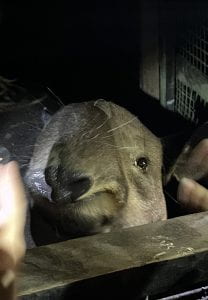
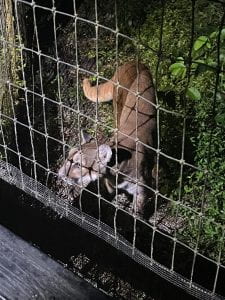
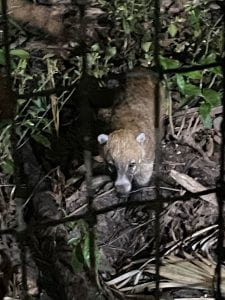
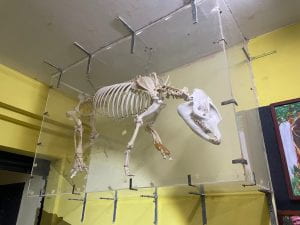
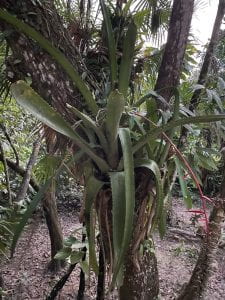
Day 7: Sea Ya Later Glover’s
Our last full day at Glover’s 🙁 We started it off with our last data collection for Sunday’s research question about coral cover and sea urchin abundance at a non-MPA site. This was pretty quick as we have all become really efficient with our methods and were even able to collect 177 (!!!) sea urchins, all Echinometra viridis. It was pretty sad how dead this reef was but I still saw an Amber Pinshell mollusk and some Common Sea Fan. We were also able to go to a protected area where there were so many different reef fish and I got to dive down a lot to observe them closer. The water was pretty rough but it made it all the more fun! I saw lots of Branching Vase Sponge, saucer leaf brown algae, Jania spp. and Amphiora fragilissima red algae, a parrot fish, more French Angel Fish, a puffer, and some stag horn coral! Also, Dr. Solomon secured us our third lion fish of the trip, a small but the perfect addition for our collection.
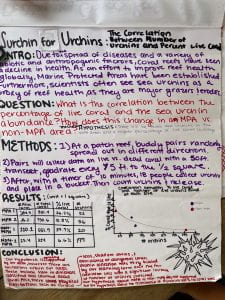
After finishing up our poster for the experiment, we had a few topic lectures so we would have more time for the lion fish ceviche!! After dinner, we gathered in the wet lab and first dissected the fish. We had three different sized ones: Snack, Appetizer, and Main Course. This was of course based on their sizes, and I got to work on Main Course, and it was hugeeee. We first took the 680g (!!) fish and measured the gape width and length which was about 3 cm and 3.25 cm respectively. Then, we sexed it and found out that it was a male before cutting open it’s stomach to see what was inside. It had these two little pieces that were pretty digested but we think it may have been some kind of invertebrate. It was super cool to be able to analyze the food that we were about to eat, especially something that is harmful to our environment. After all the fish were gutted and cleaned, Dr. Solomon made it into a delicious ceviche that we enjoyed with some plantain and corn chips. Highly recommend, 12/10 experience and a great way to end the first part of our trip.
– Sophia
Day 6: One Man’s Trash.. Is Still Trash…
Even though the weather has been kind of windy and almost stormy recently, we decided to explore the fore-reef this morning! The water outside the atoll was choppier than usual but that’s what made it fun. I swear my gear hates me as my fin buckle broke (but Dr. Correa fixed it in true marine biologist fashion with some capo ties), and then as I was jumping in, my snorkel became detached from my mask and I had to dive down to grab it… As we were in the water, the swells were soothing and it was amazing to look at the drop-off of the slope. Here, there was so much coral growth and even a Green Sea Turtle! We also saw lots of Comb Jellies and some unidentified blue fish (possibly parrotfish?). No specific red algae sightings as we were too far up to exactly see anything but I am sure there was plenty on the sea floor below. Because of the weather and character of the waves, we sadly were only in the fore-reef for about 30 or so minutes. However, I am now super motivated to try to get scuba certified so I could explore more cool places like it for deeper depths and longer periods of time!!
After lunch we then began our next experiment, taking a break from our reef experiment, we began a new one that was about picking up trash and cleaning the shore line of the Middle Caye. We were trying to figure out how much of the trash would have to be transported to shore and how much could be burned. Before we began, Nate gave a presentation about marine debris and all of the different sources of trash (80% of which is from land based sources) and learned about the Gulf of Honduras Gyre that is a current that circulates the trash around and pushes it towards Glover’s Cayes. As Elena and I were cleaning up a small ~ 30 square foot area in only 30 minutes, we were able to pick up 28.7kg of trash… and it didn’t even look like we made a dent in it. With everyone’s combined efforts in three different areas, we were able to collect a total of 64.54kg of trash within an hour. Absolutely insane. Also, because of transportation issues, Grover’s has to burn all of the trash (except for glass and metal) because there is simply too much trash for them to transfer to landfills with the amount of boats that they have/logistics. As we were sorting the trash, we went through so many everyday items that it really made you start thinking about what products you consume/use and how they are packaged. I now am super interested in beach clean up as it is a direct way to help our ocean and maybe even join Rice’s Beach Cleanup group. (Also someone found a super cool mummified box fish !!!)
After some music to pick up our energy while sorting trash, making a poster and presenting it, we had some free time before and after dinner. After dinner, one of our marine safety officers, Ruth, explained some of Belize’s history which is so interesting. There are only 400,000 people in Belize and it’s about the size of Massachusetts but it has such a diverse population. There are foods and languages from all different cultures: Indian, Chinese, Kriol, British, Mestizo, etc, it sounds amazing. I think she has convinced all of us that Belize has a lot to offer and that we all need to visit more 😉
– Sophia
Day 5: Sea Eggs, Sea Stars, and Spines Oh My!!
After waking up with even more sand fly and mosquito bites on my legs, we went out to go to carry out some more TFB shenanigans. Continuing data collection for yesterday’s research question, we went out to two Marine Protected Areas to measure the dead vs alive coral found. It was beautiful as always (even though there was a significant amount of dead coral covered in macro-algae and disease…), and we collected sooo many urchin – 108 total between the two areas! There were also a ton of different echinoderms in the second MPA: lots and lots of Brittle Sea Stars, a Sea Biscuit, and a West Indian Sea Egg. Other people also saw some tunicates (aka Sea Squirts aka one of my taxon identifications) that were a blue-ish color!! I was also able to identify three different red algae throughout the day: Jania spp., Galaxuara spp., and lastly Amphiora fragilissima. It’s been really fun trying to see where they might show up and how they might vary depending on their location.
We then had some free time after lunch to work on our field notebooks until 4pm when we went out on an optional snorkel to explore the nearby reef crest. We snorkeled by the area that is after the absorption of the wave energy and got to see what happens with an exchange of the cold ocean water into the warm water of the Caye and a creation of drastic fluctuating temperature differences. Here, it was very much a macro-algae dominated area (tons of sargassum, Mermaid’s Fan, Amphiora fragilissima, white scroll brown algae, Mermaid’s Cup) and much of the coral was dead.

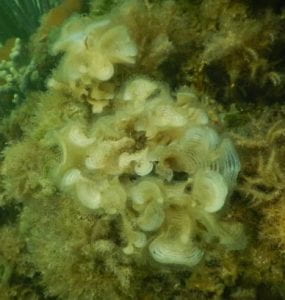
However, Dr. Correa was explaining that the groups of coral coral that were alive must be pretty resilient and are the coral that researchers are looking into to understand as to why/how they are able to survive these extremes. They can then take this information and apply it to other coral (genetically evolve them, etc.) to try to make them more resilient to drastic temperature changes and hopefully save more corals from climate change.
For the rest of the night after dinner we were lucky enough to have two guest speakers: one from the Belize Fisheries Department and one from the Belizean Coast Guard. They informed us on their roles within Belizean waters and within Glover’s atoll, especially with illegal fishing, enforcement of marine laws, and protecting the reefs. They all play such an important role in preserving the reefs and educating fishermen as to how they can continue their livelihood but in a sustainable way. Hopefully so both parties can coexist with a positive outcome and many sustainable habits that will help these waters stay as healthy for as long as they can.
– Sophia
Day 4: A Field Aquarium
Starting a new experiment today, the group came up with the research question “What is the correlation between the percentage of live coral and the sea urchin prevalence? How does this change in a protected versus unprotected zone?” We will be collecting data for this experiment over the next couple days, starting with today. After coming up with the experiment layout, we had some extra time before lunch so we went to the shallower sea grass area on the North side of the island to try to collect as many organisms as we could find into buckets. We were able to find conch, mantis shrimp, a lobster, a Diadima antillarum (a venomous urchin), corallomorphs, anemone, and even some Crustose Corralline red algae! One cool fact that I learned today is that spiny lobsters don’t have claws, unlike the ones that we see in the US. It was like our own little aquarium (which releases the animals back into the ocean of course).
After lunch, we went out on the boat to begin collecting our data. We first went to a patch we went to wasn’t a Marine Protected Area and was pretty shallow. Here, there was a lot of coral rubble and diseased coral, and it was pretty difficult to keep still with the current. To estimate the number of sea urchins in the area, we were all given 10 minutes to collect as many as we could. I was able to find a couple, but they were both underneath rocks that I couldn’t break. We ended up finding 20 different urchins! Also Dr. Correa picked up some Galaxuara spp. (a red algae) that was actually all over the sea floor. We then moved onto a MPA and got to snorkel around, just to explore. There was a huge difference in the landscape (obviously there were topography factors involved in the difference but still) with an abundance of health coral, super diverse grouping of fish and coral, and it was absolutely stunning. Here, I was even able to identify Jania spp. (a red algae) which was actually everywhere throughout the reef. I also was able to identify Fire Coral, Sergeant Fish, Dusky Damsel Fish, French Angel Fish (maybe one of my favorites now), White Scroll Algae, Boulder Star Coral, and Whitestar Sheet Coral. AND Dr. Solomon was able to spear a Lion Fish so we will be making that into some delicious Lion Fish ceviche tomorrow or so!!
– Sophia
